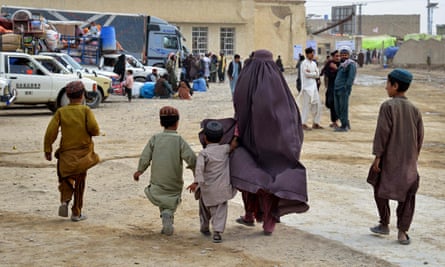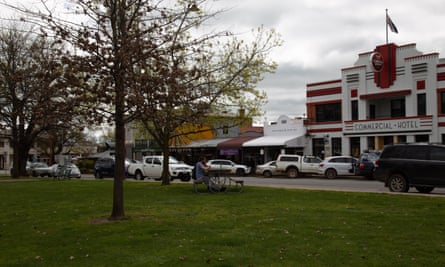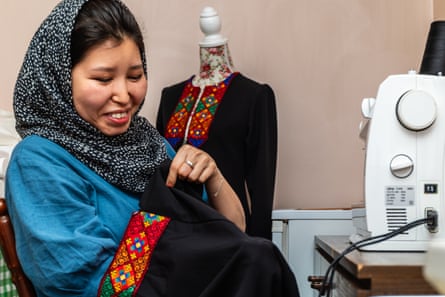Sakineh and her family were granted residency in Australia six months ago.
After fleeing the war in Afghanistan and seeking refuge in Iran, the widowed mother-of-two settled in Bendigo in Victoria’s north along with her teenage sons. It was a world away from the turmoil she’d come to know.
“We still miss our family and our old house,” Sakineh says. “Saying goodbye to family was the hardest part of our leaving.”
Sakineh’s household is one of more than 80 sponsored to move to Australia in the past 18 months as part of the community refugee integration and settlement pilot (Crisp).
The program’s first refugee intake arrived in August 2022, with the federal government selecting those identified by the UN high commissioner for refugees as being in the most urgent need of resettlement.
The refugees arrive as permanent residents who are eligible for government-funded English classes, Centrelink and Medicare, and are assisted by community supporter groups of five or more adult volunteers. The supporter groups provide 12 months of practical support, assisting with accommodation, local orientation and access to public services.
Lisa Button, the chief executive of Community Refugee Sponsorship Australia (CRSA), says more than 320 refugees from countries including Afghanistan, Iraq, Syria, Congo, El Salvador and Guatemala have settled in dozens of locations across the country since the program’s launch.
Button says the program contributes to the enrichment of Australia’s regional towns.
“It’s an opt-in program, so rather than the federal or state government making top-down decisions about where refugees get settled, it’s an invitation for anyone to welcome new migrants and they can do that for a variety of reasons,” she says.
“For some it’s for humanitarian reasons, for others it’s multiculturalism and diversity or wanting to boost the population or workforce.
“I think we’re already starting to see where there are clusters of refugees arriving through the program, that the availability of services in our communities grows to meet their needs.”
Alison McClure leads the Bendigo community support group. She says the way the city has embraced the families has been heartwarming.
“The joy the Crisp team gets from going on the settlement journey with our new families is a wonderful gift,” she says.

Salah and his family were also sponsored through Crisp. Originally from Iraq, they resettled in Warrnambool in Victoria’s south-west a few months ago. He says they have always felt welcome, with his support team akin to family.
“There is no discrimination,” Salah says. “Everyone is very friendly and always has a smile on their faces and loves to help us.
“The resettlement program also helped us live a free and dignified life.”
It’s one of several programs focusing on resettling new arrivals in regional areas. In Ararat in western Victoria, a group of Karen migrants have resettled as part of a state government program to address the decline in the city’s population while boosting the workforce.
The first group in the regional workforce pilot arrived in 2022, and have since filled job shortages across the manufacturing, meat processing, childcare, agriculture and IT sectors.
The Ararat rural city council chief executive officer, Tim Harrison, says sporting clubs, businesses, education providers and faith-based organisations are working together to build a long-term and culturally safe settlement for the new arrivals.
“Migrants play an integral role in our region’s economic growth and prosperity,” Harrison says. “Local employers have come to recognise the value of our Karen community, specifically the dedication and strong work ethic they bring to an organisation.”
Volunteer organisation Rural Australians for Refugees (RAR) has supported almost 40 humanitarian visas for refugees from Afghanistan.
The national president, the Rev Paul Dalzell, says the Victorian high country town of Mansfield recently welcomed a group of Hazara refugees, assisting them to source work, learn English and volunteer in the Country Fire Authority and local theatre.

Dalzell says the community was initially “sceptical through lack of knowledge” and had since “embraced amazingly” the new arrivals.
“You can see the quality of life within the [refugees] themselves and how they’ve demonstrated goodwill and gratitude,” he says. “They’re really happy to be alive.”
Dalzell says the organisation is working on its own structured scheme to sponsor more Afghan asylum seekers to north-east Victoria.
“The idea behind Crisp is that you can’t nominate who you want to come into Australia, but many of our members know the refugees. There is a large cohort of Afghans whom we could gradually introduce through our own scheme,” Dalzell says.
“We are in discussions to see if our program can be a model for a ‘named’ scheme as an extension to the current Crisp scheme.”
The federal member for Indi, Helen Haines, says RAR volunteers “embody the best of Australia’s generous spirit”.
“By working directly with highly vulnerable people in Afghanistan to bring them to safety in Australia and welcome them to the community in Mansfield they have a profound impact,” she says.
“Not only do they work directly with refugees, but effectively with all levels of government to highlight the way their model could be expanded.”
Community sponsorship was highlighted at the Global Refugee Forum held in Geneva this week.
In August, the federal government announced it had expanded its humanitarian intake from 17,875 places a year to 20,000.
The minister for immigration, citizenship and multicultural affairs, Andrew Giles, said the government aspired to gradually increase its community sponsored and other complementary places to 10,000 in addition to its humanitarian intake, a pledge the government reiterated at the Geneva forum.
The Crisp and RAR’s intake currently sit within Australia’s humanitarian quota.
Button says CRSA would continue advocating for Crisp to become “structurally additional” and sit within a separate community sponsorship quota, so even more refugees get the opportunity to “rebuild their lives in safety and contribute to the Australian community through this community-led model”.

For Sakineh and her boys Ehsan and Erfan, it has opened up a wealth of opportunities.
“Learning a new language and talking with other people was the hardest part of resettling in the new community,” Sakineh says. “[But it] helped us find somewhere to live, helped us enrol in school and Tafe, and practise using public transport in Bendigo, as well as practising our English.
“We are very grateful for all the help from the Bendigo community.”

